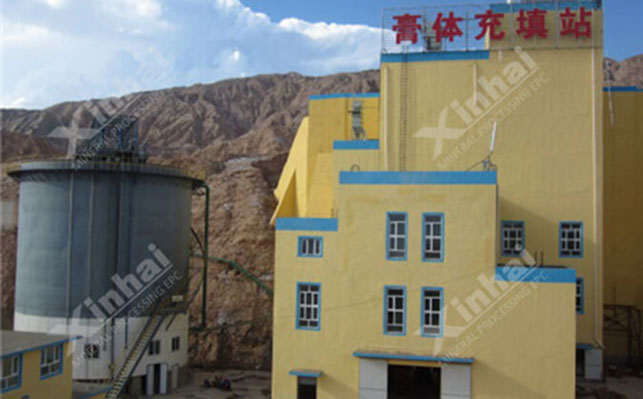
15311826613
Click to add WeChatLead-zinc tailings are waste materials obtained after ore dressing. The concentrate is selected and refined, while the tailings are piled in the tailings pond. In the early days, tailings ponds were mostly stored in wet discharge. Over the years, tailings water may leak out of the mountain and affect the surrounding land and environment. In case of heavy rain, it may also cause dam collapse. In order to improve and avoid such adverse factors, the focus has been on dry storage of tailings. Although the adverse factors have been reduced, the storage of a large amount of tailings has occupied a large amount of land, seriously wasting land resources. So in addition to dry stacking, what other methods are there for lead-zinc tailings treatment? Let's learn about it together.
At present, the main methods for lead-zinc tailings treatment are tailings re-selection, tailings backfilling the empty area and tailings making other materials.
Lead-zinc tailings reselection is to recycle valuable elements in tailings. Usually, lead-zinc tailings also contain lead, zinc, sulfur, barite, fluorite, and mica. When the content of one of these minerals has a recyclable value, the valuable elements can be recovered through the reselection process. The following are the available lead-zinc tailings re-selection process methods:

Regrinding-flotation process: This method is mainly used for reselection of sulfide lead-zinc tailings. The tailings often contain valuable minerals such as galena, sphalerite, pyrite, chalcopyrite, etc., and the gangue minerals include calcite, quartz, dolomite, mica, etc. Through the regrinding-flotation process, the recovery rate of lead-zinc minerals can be further improved.
Priority flotation process:It is mainly used for reselection of oxidized lead-zinc ore. The tailings of this type have complex components and unstable associated components. Therefore, desludging is required before flotation to improve flotation indicators and reagent dosage.
Mixed-partial flotation process:This method is mainly used for reselection of tailings containing both oxidized lead-zinc ore and sulfide lead-zinc ore. First, the lead-zinc ore tailings are obtained by mixed flotation, and then the oxidized lead-zinc ore, lead concentrate and zinc concentrate are separated in turn.
Flotation-weak magnetic separation-flotation process:When the lead-zinc tailings contain refractory pyrrhotite, this method can be used to recover sulfur and iron in the tailings, which can effectively reduce the content of harmful impurity sulfur in the iron concentrate.
Gravity-flotation process: It is mainly used to reselect barite minerals in lead-zinc tailings. Low-grade barite can be effectively recovered through spiral chute desludging, shaking table enrichment, regrinding and barite flotation.
Magnetic separation-flotation process: Since lead-zinc tailings contain a small amount of siderite, mica and a small amount of fluorite and other minerals, which are the main impurities affecting the recovery of feldspar and quartz, it is necessary to first remove impurities through magnetic separation, and then obtain feldspar and quartz minerals through flotation. The process can adopt a high-gradient magnetic separation to remove iron, and the magnetic tailings are subjected to a roughing selection and a scavenging selection flotation process to remove impurities such as fluorite and mica.
Backfilling of the empty area with lead-zinc tailings means that the tailings slurry is dehydrated and concentrated to a certain condition, and then filled into the empty mining area by adding specific additives. This backfilling not only greatly reduces the stockpiling of tailings, but also alleviates the occupation of land. In addition, the filling material can support the roof and surrounding rock of the empty area, enhance its stability, and reduce the possibility of ground collapse. There are two methods for backfilling the empty area with tailings: dry backfilling and wet backfilling.

Dry backfill: Backfill the dry tailings directly into the empty area, which is suitable for arid areas or when the tailings have a low water content.
Wet backfill: Backfill the tailings after mixing them with water into a slurry, which is suitable for situations where the tailings have a high water content or need to be backfilled quickly.
During or after the backfilling process, the stability of the goaf and the surface deformation need to be monitored to detect and deal with problems in a timely manner.
Lead-zinc tailings are a composite mineral raw material that can be used to produce a variety of building materials such as cement, bricks, concrete aggregates, etc. Among them, in terms of making cement raw materials, since most of the oxide components in lead-zinc tailings are similar to the raw materials required for cement production, and they contain a small amount of trace elements such as zinc, lead and copper, these elements have mineralization and fluxing effects on the burning of cement clinker, which can effectively improve the burnability of raw materials and increase the strength of clinker. In addition, lead-zinc tailings can also be made into fertilizers, microcrystalline glass and refractory materials.
The above are several effective methods for lead-zinc tailings treatment. By analyzing the ore samples of copper, lead-zinc tailings, the treatment method of the tailings can be determined according to the different properties of the tailings, so as to achieve the maximum comprehensive utilization rate of lead-zinc tailings.